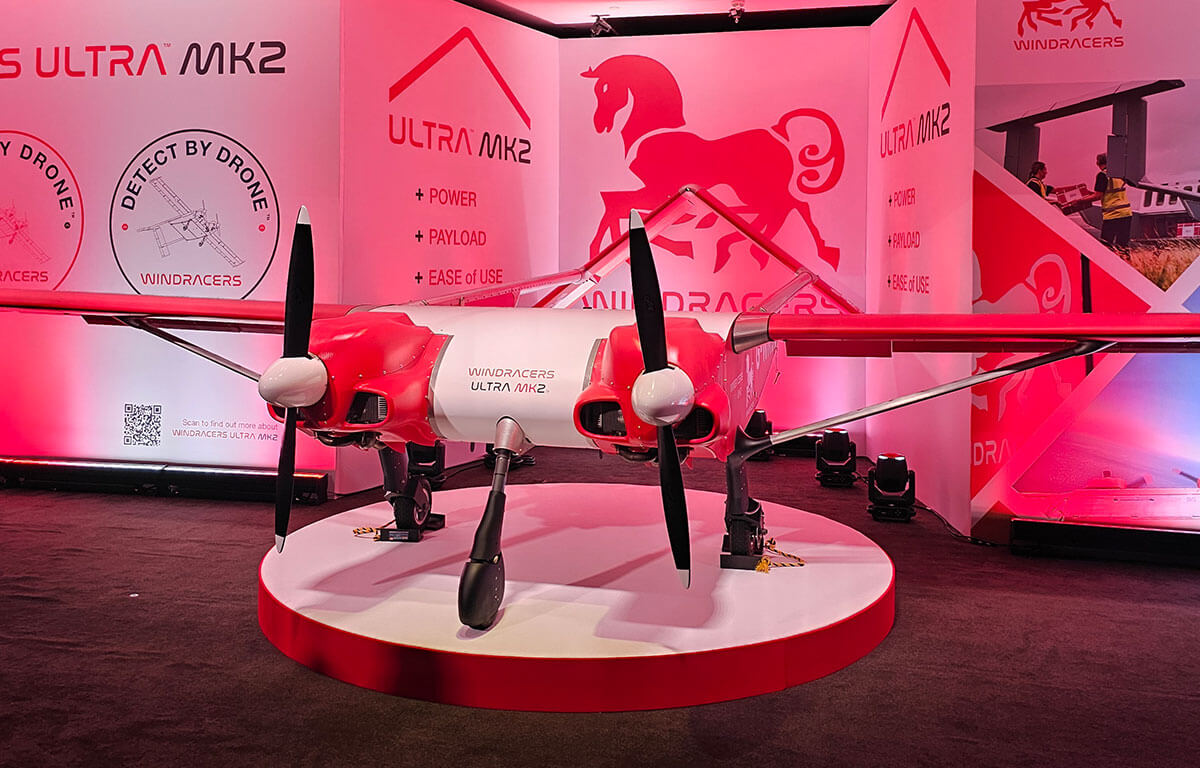The UK continues to position itself as a global leader in drone technology and AAM, having made significant strides in regulatory frameworks, industry innovation and practical applications. However, the journey has not been without its challenges for stakeholders who must navigate complex regulations and public concerns.
Growing Profile Across Sectors
In the UK, drones are increasingly being recognized for their versatility across a wide range of sectors:
- Construction: Drones are revolutionizing site surveys and 3D modeling.
- Agriculture: Drones are enhancing crop monitoring and precision farming.
- Public safety: Agencies are leveraging drones for rapid response and disaster management.
- Defense: This sector continues to innovate with unmanned aerial systems for surveillance and tactical operations.
- Events Industry: This dynamic industry is also embracing drones, with flagship events like DroneX taking center stage.

Scheduled for September 30 to October 1, 2025, at London’s ExCeL, DroneX will showcase cutting-edge advancements and foster collaboration among industry leaders, further solidifying the UK’s position as a global hub for drone technology. It will also add multidomain events to cover land and sea robotic and autonomous solutions.
Regulatory Frameworks
To facilitate all of these use cases, the UK Civil Aviation Authority (CAA) and standards bodies have been proactive in shaping the regulatory landscape for drones and AAM.
Class Marking Framework
For the CAA, a key milestone was the March 2025 introduction of the Class Marking framework for drones in the Open Category (low-risk drone flights and leisure activities that weigh less than 25kg).
Based on retained EU law, it aims to enhance safety and security of drones by requiring compliance with stringent manufacturing product standards. As of January 1, 2026, the CAA will implement and oversee a conformity assessment framework to ensure manufacturers demonstrate compliance with designated standards applicable for class marked drones, both domestic and imported.
Future Flight Systems Guide
Additionally, the British Standards Institute (BSI), the UK’s national standards body, responsible for developing and promoting British Standards and representing UK interests in international and European standards organizations, released PAS 1905:2024, offering guidance on regulatory principles for drones and eVTOL aircraft. Designed for new entrants and existing organizations in the aviation sector, including supply chain partners, investors and regulatory bodies,its main themes include:
- Regulatory Framework: The guide aligns with the UK aviation regulatory system, emphasizing a proportionate, risk-based approach to balance operational viability and safety.
- Management Systems: It highlights the importance of organizational structures, safety management systems (SMS), and quality management systems (QMS) in ensuring compliance and operational safety.
- Assurance Processes: The document outlines processes for risk assessment, hazard identification and safety assurance, crucial for maintaining operational approvals and certifications.
Advances in BVLOS
BVLOS operations represent a critical frontier for the drone industry. Several initiatives highlight the transformative potential of drones in logistics and public services.
BVLOS Trials
The CAA has approved several BVLOS trials, including the Apian London Health Bridge project, which focuses on medical deliveries, and AutoSpray Systems’ agricultural applications. These trials aim to gather essential safety data and refine policies for integrating drones into shared airspace.
Sandboxes
The CAA also introduced an innovation sandbox program to advance BVLOS capabilities. Projects like Project Lifeline and Amazon Prime Air explore applications ranging from medical deliveries to consumer goods.
Real World Ops
For its part, industry has been forging its own path for BVLOS. Self-styled low cost logistics champion, Windracers has made significant strides with its Ultra UAV platform, focusing on middle-mile logistics and connecting remote communities through reliable and efficient drone delivery services proven in successful trials for the Royal Mail and the British Antarctic Survey. It has expanded its operations internationally, including opening an AI research center in the U.S.

Industry Push Back
Despite these advancements, the UK regulatory environment has faced criticism. ARPAS-UK, the UK’s trade association for the drone industry, has expressed disappointment with the scheme of charges and the implementation of some CAA regulations.
The organization has highlighted concerns over the high compliance costs and the perceived conservatism of some policies, particularly where the implementation of Specific Operations Risk Assessment (SORA) methodologies will be key. ARPAS-UK advocates for more proportionate regulations that balance safety with operational flexibility, particularly for lower-risk operations like some Beyond Visual Line of Sight (BVLOS) flights and in particular those in Atypical Air Environments (AAE).
The Movers and Shakers
The UK’s AAM sector reflects both promise and pragmatism as it navigates the challenges faced by the global eVTOL industry. While several international companies struggle, the UK is leveraging its established aerospace heritage and regulatory foresight to advance its position. Several initiatives and companies are driving advancement in UK AAM.
Future Flight Challenge
The UK Research and Innovation (UKRI), a leading UK public research funding agency, plays a crucial role in investing in research and innovation across a wide range of fields, from biodiversity conservation and quantum computing to space exploration and healthcare. Its Future Flight Challenge continues to be a cornerstone of the country’s AAM ecosystem.
This initiative brings together industry, academia, and government to accelerate the adoption of drones and AAM technologies.
Key players include Midlands Aerospace Alliance and Achieving the Difference, which focus on regional integration and practical applications.
The Future Flight Challenge has enabled collaborative efforts across academia, government, and private industry to prioritize cargo applications and emergency response over the more complex urban passenger market. These pragmatic shifts, combined with the UK’s emphasis on developing critical infrastructure like vertiports and flight corridors, showcase a nation recalibrating its focus to adapt to the evolving AAM landscape. This resilience positions the UK and UK companies like Skyports to play a pivotal role in shaping the future of AAM while setting realistic and scalable goals for adoption.
Homegrown Innovators and Operators
The UK is home to a thriving ecosystem of drone operators and propulsion innovators. Besides those mentioned, a few other companies are leading the charge with innovative designs and strong partnerships:
- Vertical Aerospace: This company’s VX4 eVTOL aircraft remains poised for certification and commercial flights in 2028, despite facing funding and certification hurdles.
- Anduril: This American tech startup has announced plans to establish a military drone factory in the UK. This will potentially create thousands of jobs. This move underscores the UK’s growing appeal as a hub for drone and AAM innovation.
- Heliguy and COPTRZ: These leading operators provide comprehensive drone training, consultancy, and tailored solutions for industries ranging from public safety to agriculture.
- ePropelled: With manufacturing in the US, in addition to the UK and India, this company, pioneering electric and hybrid propulsion systems, offers state-of-the-art motors and power management solutions for unmanned aerial vehicles, as well as ground and marine platforms.
- RCV Engines: Known for their multi-fuel engine technology, this company specializes in heavy-fuel propulsion systems ideal for both fixed-wing and rotary UAVs.
All of these companies exemplify the UK’s commitment to fostering innovation, diversity and resilience in the drone industry.
Closing Thoughts: Seizing the Moment

The UK is at a pivotal moment in its journey toward becoming a global leader in drones and AAM. This future hinges on addressing some key challenges. Updated guidelines for BVLOS operations and flight restrictions are essential for scalable adoption. Public concerns about noise, privacy, and wildlife impacts must be addressed to build trust and acceptance. Infrastructure development is another critical area. The creation of drone hubs and networks requires innovative funding models to overcome financial barriers. Collaboration between stakeholders will be vital to ensure that the regulatory framework evolves in tandem with technological advancements. By balancing innovation with societal needs, the country can unlock the full potential of these technologies to transform transportation, logistics and public services.
*Philip Hicks is the Principal Consultant and Founder of Pravo Consulting, a specialist communications advisory firm. With a focus on disruptive technologies, including autonomous systems, Philip brings a wealth of expertise in strategic communication, market analysis, and industry insights. His work spans across sectors such as drones, robotics and AI in commercial and military markets, where he excels in simplifying complex concepts for diverse audiences. Known for his analytical approach and meticulous attention to detail, Philip has been instrumental in shaping narratives that drive innovation and collaboration within the tech industry. Through Pravo Consulting, he continues to empower organizations to navigate the evolving landscape of cutting-edge technologies.
By: Philip Hicks

